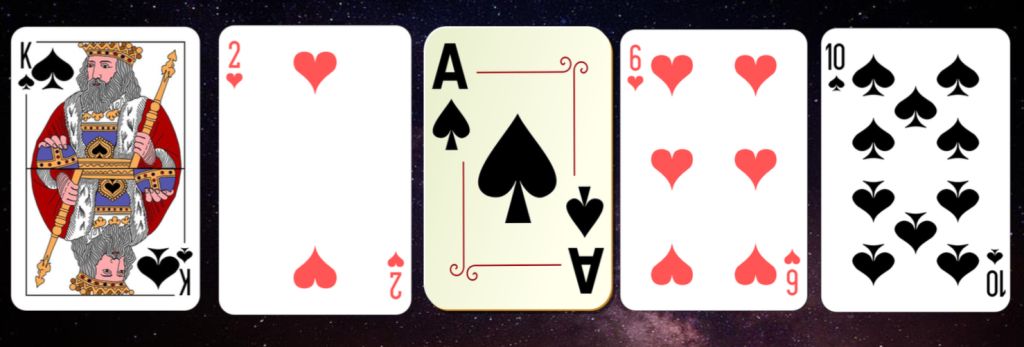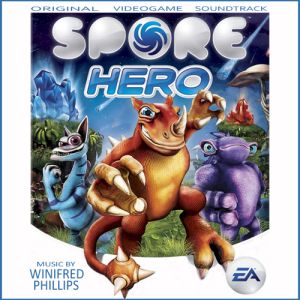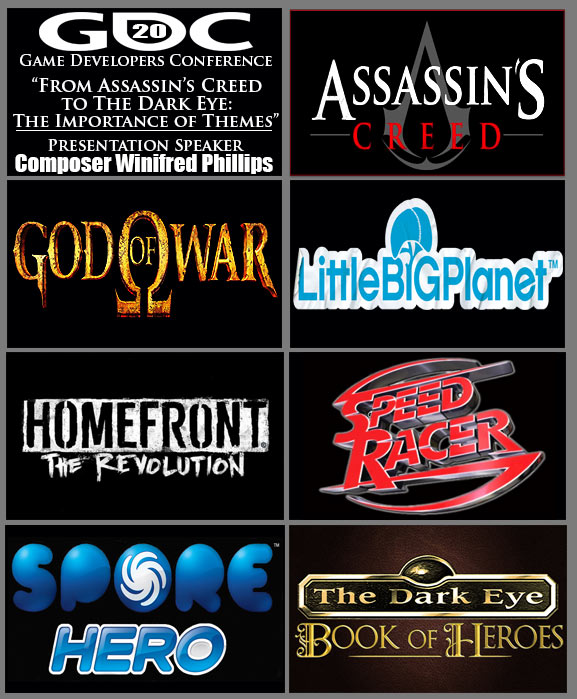
Featured Blog | This community-written post highlights the best of what the game industry has to offer. Read more like it on the Game Developer Blogs or learn how to Submit Your Own Blog Post
Game Composers and the Importance of Themes: Interactivity in Game Music (Pt. 5)
Let's explore what happens when musical themes are employed within more complex interactive music systems! This is the last installment of the five-part article series on the use of thematic content in video game music composition.


By Winifred Phillips | Contact | Follow
Hey everybody! I'm video game composer Winifred Phillips, and welcome to the fifth and final installment of my article series based on the presentation I gave at this year's Game Developers Conference in San Francisco. My talk was entitled "From Assassin's Creed to The Dark Eye: The Importance of Themes" (I’ve included the official description of my talk at this end of this article). In my presentation, I discussed the music I composed for several video game projects, including Assassin's Creed Liberation (Ubisoft), God of War (Sony Interactive America), LittleBigPlanet (Sony Interactive Europe), Homefront: The Revolution (Deep Silver), Speed Racer (Warner Bros Interactive), Spore Hero (Electronic Arts), and The Dark Eye: Book of Heroes (Wild River).
If you missed any of the articles in this series, you can find them here:
In the previous installments of this series, we discussed the importance of repeating musical themes, using the variation technique and fragmentation to support different gameplay types. So now, let’s explore what happens when musical themes are employed within more complex interactive music systems.
Interactive music constructs are fantastic ways to make music feel more responsive to player choice. But these interactive systems can also throw up big roadblocks when it comes to thematic composition choices. Here are a couple of examples within two different systems – one where a thematic approach encountered some obstacles, and another in which the going was much smoother. First, let’s talk about Horizontal Resequencing.
Horizontal Resequencing

Imagine a piece of music as a deck of cards, with each card representing a short section of music. Now imagine that the game can shuffle those cards whenever it wants, completely changing the musical order. That’s horizontal resequencing in a nutshell.  As a composer, it can feel like we’re always pulling a joker or a wild card – it makes things unpredictable, which makes thematic writing hard to pull off. Here’s an example:
As a composer, it can feel like we’re always pulling a joker or a wild card – it makes things unpredictable, which makes thematic writing hard to pull off. Here’s an example:
In Spore Hero, there’s a dancing minigame that has your character competing against other non-player characters. The music is structured so that it can move quickly from general dancing to specialized moves.
When I originally composed the dancing music, I incorporated the main Spore Hero theme into it. Here’s what that sounded like:
Unfortunately, when the game switched over to specialized dance moves, that melodic theme got abruptly cut off – which really didn’t work. So we ended up just removing the melody altogether. Here’s what the final dancing sequence was like:
The final result worked well, and the horizontal resequencing system moved gameplay forward, but it also temporarily stopped reinforcing the musical identity of the game. Fortunately, as we’ve previously discussed, there were plenty of other opportunities in Spore Hero to assert a distinctive musical signature. In another project, I tackled a similar issue from within a very different interactive system: Vertical Layering.
Vertical Layering
 Imagine music as a game of Jenga – picture a tower of wooden blocks. Now imagine the game can pull blocks out of that tower, or add blocks to the top of it. That’s what vertical layering is all about. The music is stacked in simultaneous layers, and the system adds and subtracts those layers. This poses challenges when we’re trying to compose thematically. Case in point:
Imagine music as a game of Jenga – picture a tower of wooden blocks. Now imagine the game can pull blocks out of that tower, or add blocks to the top of it. That’s what vertical layering is all about. The music is stacked in simultaneous layers, and the system adds and subtracts those layers. This poses challenges when we’re trying to compose thematically. Case in point:
During my work on LittleBigPlanet 2, I composed a jazz track with an extensive melody carried by scat vocals. Vertical layering allowed me to write a long, well-developed melody. However, I had to account for the fact that the system could shut the melody off at any time. Like pulling a block in Jenga, I had to make sure my whole tower wouldn’t fall down. So I structured the supporting instruments to feel subtly melodic, like a simplified version of the foreground theme. That way, the main melody could be stripped out, and the music would still work. Here’s a taste of that:
Thematic writing for interactive systems is tricky. Sometimes it works, and sometimes it doesn’t. When it doesn’t work, we have to be ready to discard the thematic hook so that the interactive construct can properly function – if that seems like the best decision. We can also set aside some interactivity in favor of satisfying thematic content, if that seems more important. The choice is never an easy one.
Conclusion
Over the course of these five articles, we’ve discussed the nature of musical themes. We’ve considered how the thematic hook can grab our attention. We’ve looked at overtly melodic themes that soar above their arrangements and more subtle thematic elements that insistently burrow into our minds. We’ve explored the power of repetition. We’ve thought about how variation and fragmentation can keep themes feeling fresh when they recur. We’ve pondered the role of themes in different types of gameplay circumstances, and we’ve examined the pros and cons of using thematic material within interactive music systems. Themes can serve as the musical signatures of the games for which they were written. As game composers, if we decide to create thematic scores, then we have to commit to that approach, and use every technique at our disposal to maximize the effectiveness and the power of our themes.
From Assassin's Creed to The Dark Eye: The Importance of Themes

(Game Developers Conference Session Description)
Through an exploration of her work composing music for games such as Assassin’s Creed Liberation, God of War, LittleBigPlanet and the upcoming RPG The Dark Eye: Book of Heroes, composer Winifred Phillips will examine the potential of thematic music to enable a game to stand out as special and unique.
By employing musical themes, a composer can infuse a game with a strong sense of character and originality.
According to research, music heard during activities is remembered vividly. Coupling this with the innately memorable nature of themes allows a game composer to create an indelible musical signature for any game. This talk will examine composition techniques that extend the life and utility of themes. Variation, development, figures, fragmentation, and motifs will be explored, along with examples of themes in combat, menus, cutscenes, and stingers. Finally, dynamic music construction will be considered, including workarounds to enable effective themes within interactive systems.
Takeaway
Using examples from several games, Phillips will discuss specific composition techniques designed to enhance the utility of thematic content. Attendees will learn how themes may be incorporated into specific game music asset types. Also included in the discussion: composition adjustments required by interactive music constructs.
Intended Audience
This session will present inspirational ideas for composers seeking to create distinctive musical signatures for their game projects. Discussion of thematic use within different types of game music assets may be helpful for audio developers engaged in preparing music design documents. The talk will be approachable for all levels.
 Winifred Phillips is a well-known video game composer whose latest project is the hit PlayStation 5 launch title Sackboy: A Big Adventure (soundtrack album now available). Popular music from Phillips' award-winning Assassin's Creed Liberation score is featured in the performance repertoire of the Assassin's Creed Symphony World Tour, which made its Paris debut with performances by a top 80-piece orchestra and choir. As an accomplished video game composer, Phillips is best known for composing music for games in five of the most famous and popular franchises in gaming: Assassin’s Creed, God of War, Total War, The Sims, and Sackboy / LittleBigPlanet. She is the author of the award-winning bestseller A COMPOSER'S GUIDE TO GAME MUSIC, published by the MIT Press. As one of the foremost authorities on music for interactive entertainment, Winifred Phillips has given lectures at the Library of Congress in Washington DC, the Society of Composers and Lyricists, the Game Developers Conference, the Audio Engineering Society, and many more. Phillips’ enthusiastic fans showered her with questions during a Reddit Ask-Me-Anything session that went viral, hit the Reddit front page, received 14.9 thousand upvotes, and became one of the most popular gaming AMAs ever hosted on Reddit. Follow her on Twitter @winphillips.
Winifred Phillips is a well-known video game composer whose latest project is the hit PlayStation 5 launch title Sackboy: A Big Adventure (soundtrack album now available). Popular music from Phillips' award-winning Assassin's Creed Liberation score is featured in the performance repertoire of the Assassin's Creed Symphony World Tour, which made its Paris debut with performances by a top 80-piece orchestra and choir. As an accomplished video game composer, Phillips is best known for composing music for games in five of the most famous and popular franchises in gaming: Assassin’s Creed, God of War, Total War, The Sims, and Sackboy / LittleBigPlanet. She is the author of the award-winning bestseller A COMPOSER'S GUIDE TO GAME MUSIC, published by the MIT Press. As one of the foremost authorities on music for interactive entertainment, Winifred Phillips has given lectures at the Library of Congress in Washington DC, the Society of Composers and Lyricists, the Game Developers Conference, the Audio Engineering Society, and many more. Phillips’ enthusiastic fans showered her with questions during a Reddit Ask-Me-Anything session that went viral, hit the Reddit front page, received 14.9 thousand upvotes, and became one of the most popular gaming AMAs ever hosted on Reddit. Follow her on Twitter @winphillips.
Read more about:
Featured BlogsAbout the Author
You May Also Like









